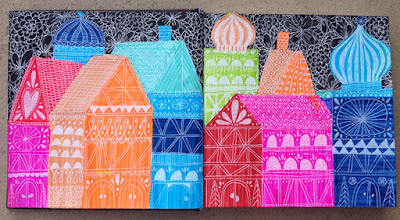Well, this week I went all in on stop motion shorts with my 5th graders. It's something I have wanted to do since seeing the amazing works that Tricia Fuglestad and Nic Hahn have done with their students the past few years. I've been trying it out with various grade levels in small doses over the past couple months. Some kinders, 2nds, and 3rds have had the opportunity to work with the process, but this is the first time full classes of a whole grade level have done it. It's been hectic, I'm learning the management of it as we go, and it has been... AWESOME!
I can't wait to share their work with our school community. I think I will set them up on a smart board in a classroom near our auditorium for our end of the year Celebration of Art to have a mini short film festival that evening. I know I'm getting ahead of myself, but I can't help it!
This is how we have been doing it- I introduce the concept of movement in art by talking about using both body/object position and repetition of said body/object. I then share a few examples of things that convey motion. I'm using outer space as a unifying theme for the project/process.
After we look at these examples, including the Thomas Anders Watkins space jump image above, I tell the kids we will be creating a stop motion short that uses both hand drawn elements and the stop motion app I have downloaded on the ipads in my class.
Things have gotten a little noisy with excited energy at this point.
I also mention that this will be a collaborative project. They will be working as a team with the person sitting next to them. There is more excitement and so anxiety mixed in with it at this point.
I share a stop motion that I made based on the space jump design with them so they get a better sense of what theirs might look like.
Before letting them at it, I review the process (following the breakdown above) and talk about how before they draw anything, they need to have a collaborative conversation with their partner. They need to develop a plan before doing anything else. I remind them that they need to do their best to keep the noise level at 2- partner talk, so everyone can focus. I give them about 15 minutes to work and then share a video tutorial I did, so they can see how the stop motion app and process will work.
When I share the tutorial, most kids are about halfway done, but some are almost ready to roll. The tutorial covers the stop motion app basics, opening, taking photos, making very small movements in between shots (SO important), taking a minimum of 20 photos, recording sound, titling, and saving to the ipad camera roll so I can upload them to my computer.
Sharing my tutorial. "Mr. Masse, that guy sounds a lot like you."
the tutorial.
I have 3 stop motion stations set up around the room for them to use. Each station has it's own, um, personality:)
If students are ready to shoot and do not want to wait for a station to become available, they may use the edge of a table to shoot down onto the floor.
When the teams finish taking pictures, deleting any frames that have issues, they go outside to record their soundtrack/voice over. A number of teams haven't been able to finish in the scheduled 80 minute session, but so many of them have stayed during recess, lunch, or after school in order to wrap it up. The enthusiasm is genuine.
So, when all is said and done, their will be over 90 stop motion shorts done by the end of the day tomorrow! Whew!
Here are some of the out of this world shorts being made by our Zamo kids this week.
And now onto clay week! (That won't be busy at all;)
































































